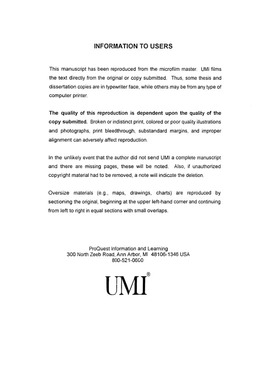| dc.contributor.advisor | Gipson, Richard C., | en_US |
| dc.contributor.advisor | Wakefield, William, | en_US |
| dc.contributor.author | Harris, Scott Holden. | en_US |
| dc.date.accessioned | 2013-08-16T12:18:53Z | |
| dc.date.available | 2013-08-16T12:18:53Z | |
| dc.date.issued | 2003 | en_US |
| dc.identifier.uri | https://hdl.handle.net/11244/567 | |
| dc.description.abstract | The purpose of this study was to identify and provide an analysis of selected highly ranked percussion ensemble works from 1970--2000. Through defined criteria, twenty-four experts were identified in the field of percussion ensemble literature and subsequently surveyed through electronic mail. These experts were asked to nominate ten large percussion ensemble works composed between 1970--2000 that in their opinion represented the highest level of musical artistry among works composed in this medium. A ranked list of fifty-nine large percussion ensemble works was identified through the nomination process. | en_US |
| dc.description.abstract | Seven of the most nominated works were chosen for analysis. The selected works and composers were: Crown of Thorns---David Maslanka, Diabolic Variations---Raymond Helble, Duo Chopinesque ---Michael Hennagin, The Palace of Nine Perfections---Eric Ewazen, The Phantom Dances---Michael Hennagin, Portico---Thomas Gauger, and Stained Glass---David Gillingham. Each analysis addressed the instrumentation, form, melodic and harmonic function, meter and rhythmic language, and performance/rehearsal issues relevant in each work. Specific techniques and interpretive design for the percussion ensemble conductor also were addressed. | en_US |
| dc.description.abstract | This study found that, while there were different opinions concerning which works represented the highest level of musical artistry, compositional design for the large percussion ensemble has developed considerably in the late twentieth century. The selected compositions analyzed in this study represented a wide variety of compositional style, approach, and technique. It was also determined that the role of the percussion ensemble conductor is significant, requiring considerable technique and interpretive skill to conduct and rehearse the selected compositions. As all of the selected compositions were commissioned and composed by professional composers, it was further noted that commissioning high-quality works is notably beneficial for the percussion ensemble art form to continue to grow and develop as a viable genre in the twenty-first century. | en_US |
| dc.format.extent | vii, 207 leaves : | en_US |
| dc.subject | Music. | en_US |
| dc.subject | Percussion instruments in literature. | en_US |
| dc.title | Identification and analyses of selected large percussion ensemble works composed between 1970--2000. | en_US |
| dc.type | Thesis | en_US |
| dc.thesis.degree | D.M.A. | en_US |
| dc.thesis.degreeDiscipline | School of Music | en_US |
| dc.note | Source: Dissertation Abstracts International, Volume: 64-03, Section: A, page: 0712. | en_US |
| dc.note | Advisers: Richard C. Gipson; William Wakefield. | en_US |
| ou.identifier | (UMI)AAI3082924 | en_US |
| ou.group | Weitzenhoffer Family College of Fine Arts::School of Music | |
